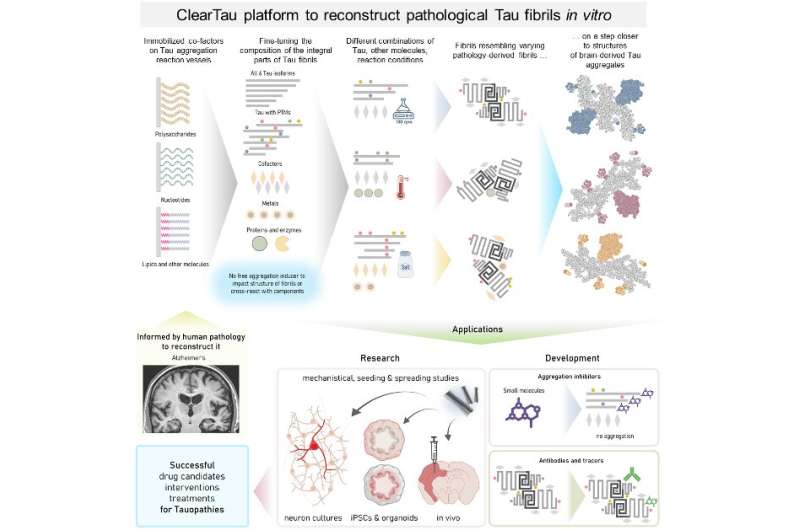This article has been reviewed according to Science X's editorial process and policies. Editors have highlighted the following attributes while ensuring the content's credibility:
fact-checked
peer-reviewed publication
trusted source
proofread
ClearTau: A new tool for studying neurodegenerative diseases

EPFL scientists have developed ClearTau, an innovative method and platform for reconstructing aggregates of the protein Tau found in Alzheimer's disease and other neurodegenerative diseases. The breakthrough may speed up the development of diagnostics and targeted therapies for Tau-related disorders.
Tau is a protein found in the human brain that plays an important role in maintaining the structure and function of nerve cells. When Tau protein adopts abnormal shapes, it can form clumps and tangles, known as tau fibrils, that disrupt the communication between nerve cells. Tau fibrillization has long been implicated in the development of neurodegenerative diseases like Alzheimer's and other "tauopathies."
Understanding how Tau fibrils form and spread to different parts of the brain is crucial in developing treatments to stop or slow down the progression of these diseases. However, studies have been hampered by the fact that inducing misfolding and aggregation of Tau requires the addition of co-factors like heparin.
Meanwhile, the resulting tau fibrils show significant differences in structure and morphology compared to those observed in brain tissues from patients. This has made it difficult to develop drugs and imaging tools that track the formation and spreading of Tau aggregates in the brain or neutralize their disease-causing properties.
Now, scientists at EPFL have developed ClearTau, an innovative, quick, cheap, and effective method for producing Tau fibrils without the need for co-factors. ClearTau makes it possible to reconstruct the complexity of aggregates found in the brains of patients suffering from tauopathies, and develop disease-specific therapeutics and imaging tools.
Published in Nature Communications, ClearTau was co-invented by Galina Limorenko, a Ph.D. student at EPFL's School of Life Sciences, and her supervisor, Professor HIlal Lashuel. ClearTau uses heparin that is previously stuck ("immobilized") onto the surfaces of the tubes used for making Tau fibrils, and produces large quantities of clean Tau fibrils faster than previous methods.
"The idea of clear Tau was inspired by technology often employed in the medical devices, such as blood perfusion or dialysis equipment, where immobilization of heparin molecules on the inner tubing is used to prevent blood clots while preventing its leakage into the bloodstream," says Limorenko. "I thought, why not apply this to Tau?"
Limorenko and Lashuel thought that they could use immobilized heparin or other co-factors known to induce Tau aggregation to nudge the protein to change its shape and aggregate. "Because these co-factors are attached to the surface of the tube, they will not get stuck inside the growing Tau fibrils, change their structure or alter their normal interactions with other molecules," says Limorenko. "We tried it and it worked."
Testing their new method, the research team found that ClearTau can efficiently produce all six of Tau's isoforms as well as truncated and mutant versions, even in the presence of other co-factor molecules than heparin, such as RNA and ATP.
ClearTau overcomes the limitations of previous methods that either required extensive time or use uncharacterized co-factor components.
ClearTau fibrils are morphologically consistent within single Tau isoforms and show key properties that make them similar to their natural counterparts, such as being positive to amyloid reporter dye, a high propensity for binding RNA, and seeding competency—the ability of ClearTau aggregates to induce the aggregation of other Tau proteins in neurons, a "domino effect" that gives rise to tauopathies.
"We believe this work represents a major advancement if the field of Alzheimer's disease and neurodegenerative diseases research in general," says Lashuel.
"Tau fibrils and aggregates in the brain are decorated with different types of chemical modifications, and interact with other non-proteinaceous molecules, whose identity remains unknown. Therefore, there is an urgent need for methods that allow for reconstructing the biochemical and structural complexity of the disease-associated Tau pathological aggregates."
Lashuel adds, "By combining the ClearTau method with other technologies that our lab has pioneered over the years, and being able to decorate Tau molecules with chemical modifications similar to those found in disease, we now have a powerful platform that enables us for the first time to screen for and identify conditions that produce Tau aggregates that are chemically and structurally similar to pathological brain-derived forms."
"This can help us develop disease-relevant models, design and validate novel therapies, identify new imaging agents for early diagnosis, monitor disease progression, and assess the efficacy of new therapies."
More information: Limorenko, G., Tatli, M., Kolla, R. et al. Fully co-factor-free ClearTau platform produces seeding-competent Tau fibrils for reconstructing pathological Tau aggregates. Nature Communications (2023). . DOI: 10.1038/s41467-023-39314-7 , www.nature.com/articles/s41467-023-39314-7





















